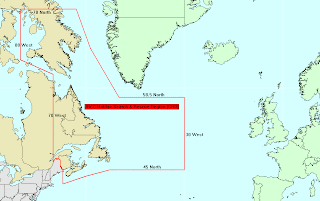Have a look at the map above - this is the area covered by the Search and Rescue Centre in Halifax. Are MP's able to view a MAP?
It is not only unacceptable for Newfoundland and Labrador lose a sub-centre - it should actually be home to the main Search and Rescue Centre currently located in Halifax.
Before you go the rally today on the waterfront - please read the information below taken from the Federal Government website.
Further - as you read it - you will notice we lost a rescue centre from Torbay in the 1970's as it was all sent to Nova Scotia. The sub-centre was supposed to make up for that. Now they want it all - when geography does not bear it out.
Is the sub-centre in Quebec City being closed?
Newfoundland and Labrador either wins this fight - or we get out. Do not let the Harper Conservatives insult or harm us anymore.
Who do you think is most at risk - from a marine perspective?
Nobody has the right to place our people at increased risk!
How about we take over forest-fire communications for Ontario, or flooding response communication in the Prairies? Why don't we take over the Search and Rescue Centre for British Columbia? There should be no reason that we can't control marine rescue for the Great Lakes and shut down Trenton.
The following is the information is taken from the federal government website.
The Halifax Search and Rescue Region (SRR) is bounded on the east at 30 degrees West Longitude, on the west at 70 degrees West Longitude, to the south at approximately 42 degrees North Latitude and to the north at 70 degrees North Latitude. This area comprises all of the Atlantic provinces, the eastern half of the province of Québec, the southern half of Baffin Island and an area of the western North Atlantic extending to 30º west, an area of approximately 4.7 million square kilometres. With over 29,000 kilometers of coastline, eighty percent of the region is covered by water.
The 1970's saw changes that provided better support for people in distress. Air resources were now located in Gander Newfoundland, and Summerside Prince Edward Island. Halifax became the sole RCC with the closing of Torbay, although the Coast Guard established Marine Rescue Sub-Centres (MRSC) in St. John's and Québec City, Québec. Aircraft began dropping pumps in aid of vessels taking on water in 1970; in January of that year, the Motor Vessel USEN #1 was the first successful recipient of a pump. The year 1970 saw the number of cases rise to a total of 963
The operations of the SAR fleet account for most of the Canadian Coast Guard SAR Program costs. On average, 65-75% of the budget for SAR is spent on the fleet. A further 8% is spent on capital projects. Rescue Co-ordination accounts for 16% and the management, monitoring and administration of the program accounts for the remaining 8%.
Rescue Co-ordination Centres and Maritime Rescue Sub-Centres
The Canadian Coast Guard jointly staffs three Rescue Coordination Centres (JRCCs) with the Canadian Forces. The JRCCs are located at Victoria, British Columbia, Trenton, Ontario, and Halifax, Nova Scotia. The Canadian Coast Guard also operates two Maritime Rescue Sub-Centres (MRSCs) at Quebec City, Quebec, and St. John's, Newfoundland. The function of a MRSC is to reduce the JRCC's workload in areas of high marine activity. These centres are staffed by SAR Co-ordinators who operate 24 hours a day, seven days a week, year round. The maritime area for which the Canadian JRCCs/MRSCs are collectively responsible for is more than 5.3 million square kilometres.The JRCCs/MRSCs are responsible for the planning, co-ordination, conduct and control of SAR operations. JRCCs/MRSCs have highly trained staff, detailed operational plans and an effective communications system. Once an JRCC/MRSC is notified that a person(s) is in danger, the SAR Co-ordinator begins to organize the rescue. All available information about the person(s) in danger is gathered and recorded and the positions of potential assisting resources in the area of the incident are determined. SAR Co-ordinators are trained to evaluate various situations and send the most effective resources to deal with a particular incident. In complex and major incidents, many resources are often sent or tasked to assist.
To fulfill our mission, our objectives are to:
- Save 100% of lives at risk.
- Reduce the number and severity of SAR incidents.
- Minimize loss of life, injury, property damage and risk to the environment.
- Support and involve the Canadian Coast Guard Auxiliary.
- Maintain the highest professional standards.
- Provide national leadership and effective SAR Program management.
- Provide international SAR leadership.
- Maximize SAR system efficiency through innovation.
- Promote volunteerism.
- Increase awareness of the SAR Program.
- Assist in the development of the National SAR Program.
- Foster co-operative SAR agreements.
- Provide humanitarian aid and civil assistance where possible.

1 comment:
After listening to a Mr John Butler, Asst Commissioner of the Canadian Coast Guard on the NTV newscast on Friday evening I was convinced. Hence, we were a no show at the rally. Anything that will enhance the service I am all for it and Mr Butler certainly pointed out that it would. I certainly have no reason not to believe the gentleman. When politics started to creep in that did it for me.
Post a Comment